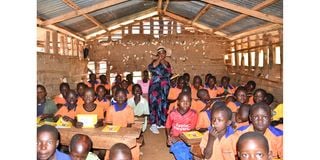Sorry state of classrooms forces pupils out of school

What you need to know:
- Officials want government to construct metallic ladders that connect teachers and pupils to schools.
Villages situated in the remote hilly and mountainous sub-counties of Sironko District are registering high cases of school dropouts, with leaders blaming the government for doing little to address the situation.
At Bunagami Primary School in Legenya Sub-county, the school registered 29 out of about 40 candidates for Primary Leaving Examinations (PLE) 2023 after about 20 dropped out.
When the Uganda National Examination Board (Uneb) released the results in January, out of 29, only two had passed in Division Two and Two others in Division Three.
The government-aided school, which sits on the ridge of Mt Elgon, conducts most of its classes in makeshift structures amid an inadequacy of desks.
It also has no staff quarters, forcing teachers to walk about 20 kilometres uphill from the lower sub-counties.
With an enrolment of 566 pupils, the school has one pit-latrine with four stanzas, which was shared by teachers and pupils until this year when the locals built a temporary one for teachers.
Mr Patrick Nakoko, the head teacher, says it’s by luck that a child completes Primary Seven in the sub-counties found in upper Sironko.
“Our pupils rarely complete the primary cycle and if they do, most of them end up dropping out either in Senior One or Two,” he said during an interview at the weekend.
When clouds show signs of rain, the pupils in the hilly schools are asked to leave their respective homes due to fear that temporary structures might collapse on them. The Daily Monitor has learnt that schools assign teachers to monitor the weather conditions, especially to see when the clouds become dark and low, a sign that the rain or storms are on the way so that learners are sent home before it pours.
Accessibility to schools such as Bunagami, Zebugugusi, Butandiga, Nabodi, Bumagabula primary schools is also difficult because learners and teachers use metallic ladders, which have replaced the wooden ones in some areas. The metallic ladders were built by the ministry of Works.
The wooden ladders are usually built by the locals through collective effort and they last about two years before they are replaced. Pupils and teachers prefer using ladders because they offer a shortcut to their respective schools and other destinations compared to using the road.
Mr Nakoko said due to the long distance, teachers arrive late and leave early thus compromising learning.
“Some of the teachers walk about 20 kilometres,” he said.
John Wadeya, a 16-year-old pupil at Bunagami Primary School, said: “We reach school when we are late and tired and during the rainy season.”
The locals in a bid to fight absenteeism, among teachers, have embarked on putting in place a temporary structure to serve as a staff quarters.
At Bumagabula Primary School, pupils report late and others leave early partly because the school has only three teachers.
Mr Tom Mwambu, the head teacher of Zebugubusi Primary School in Bukyabo Sub-county, said the lack of enough classrooms is affecting learning.
“We have high enrolment due to high population density in this area but the classrooms are not enough to accommodate the learners,” he said.
The school has an enrolment of 868 pupils with nine teachers and it had one candidate passing in Division One in 2023 PLE.
Ms Racheal Nanduga, a Primary One teacher at Zebugubusi Primary School, said her class is congested with 200 pupils.
“Marking books is hard because pupils are so many. A normal class is supposed to have about 50,” she said, adding that most of the pupils report without books and uniforms.
Mr Gershom Weasa, a district councillor for Bukhulo Sub-county, said: “We have a high school dropout rates due to teenage pregnancies and early marriages of girls between the ages of 14 and15.’’
Leaders WEIGH IN
Sironko Woman MP Florence Nambozo said: “Much as we appreciate the government for doing much for us in terms of teachers’ salary, when you go to schools found on Butandia Bunagami ridge, they conduct lessons in makeshift structures, have inadequate desks, few teachers, and when it rains, the children are sent home.”
Ms Nambozo said there is rampant absenteeism because of impossible roads, adding that the government should consider teachers in the area to benefit from hard-to-reach allowance.
Mr Isaiah Sasaga Wanzira, the area MP, said: “Sironko being in a rural setting, the rate of attraction of teachers is too low but we are engaging Parliament and government to allocate us more funding.”
Mr Nelson Kisenda, the Chief Administrative Officer of Sironko, said in this financial year, the government availed the district Shs Shs500m to construct classrooms at about three schools.
The district has 100 primary schools. “But every passing year, the number of children increases in our schools. We need more money for classrooms, pit-latrines, desks, staff houses, and teachers,” he said.




